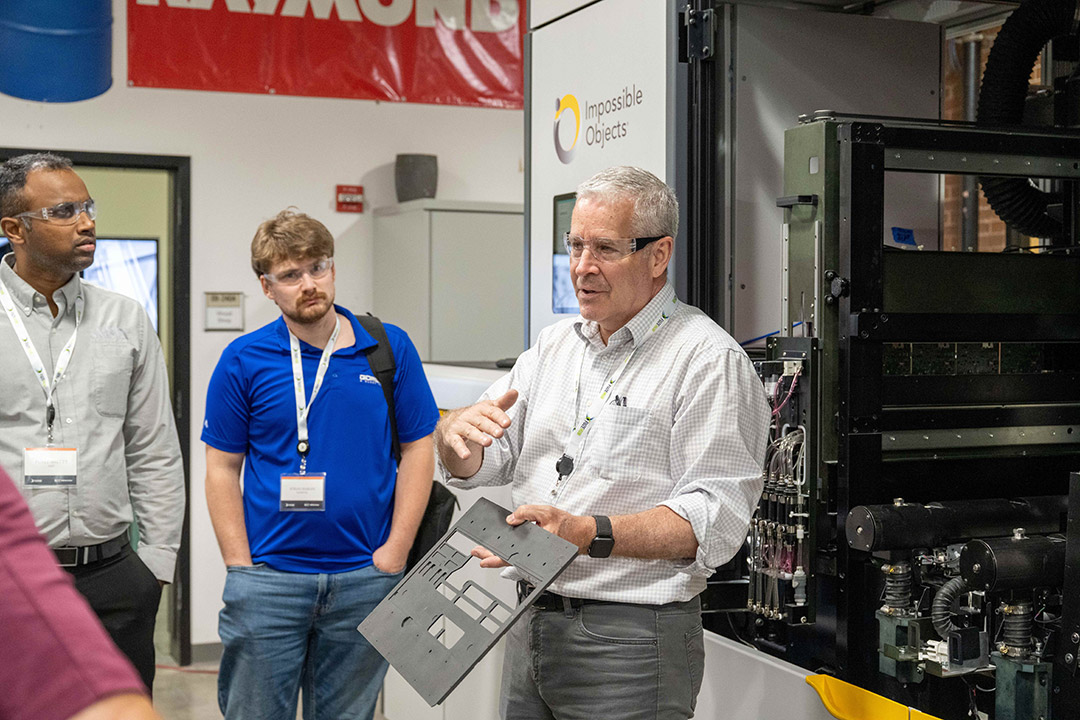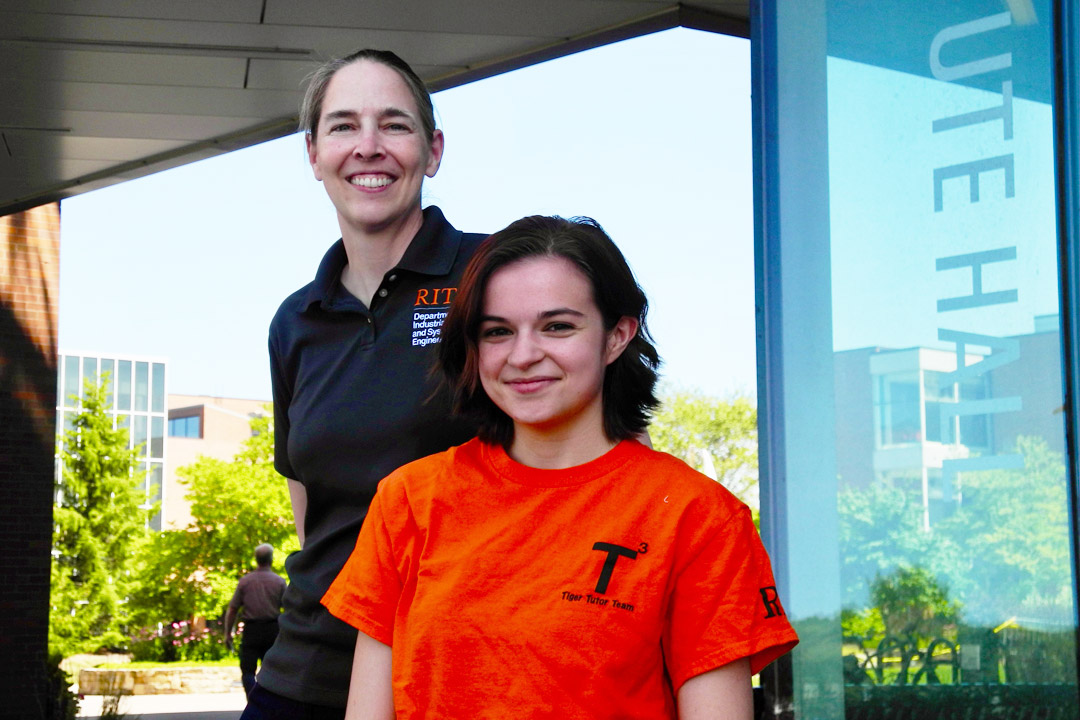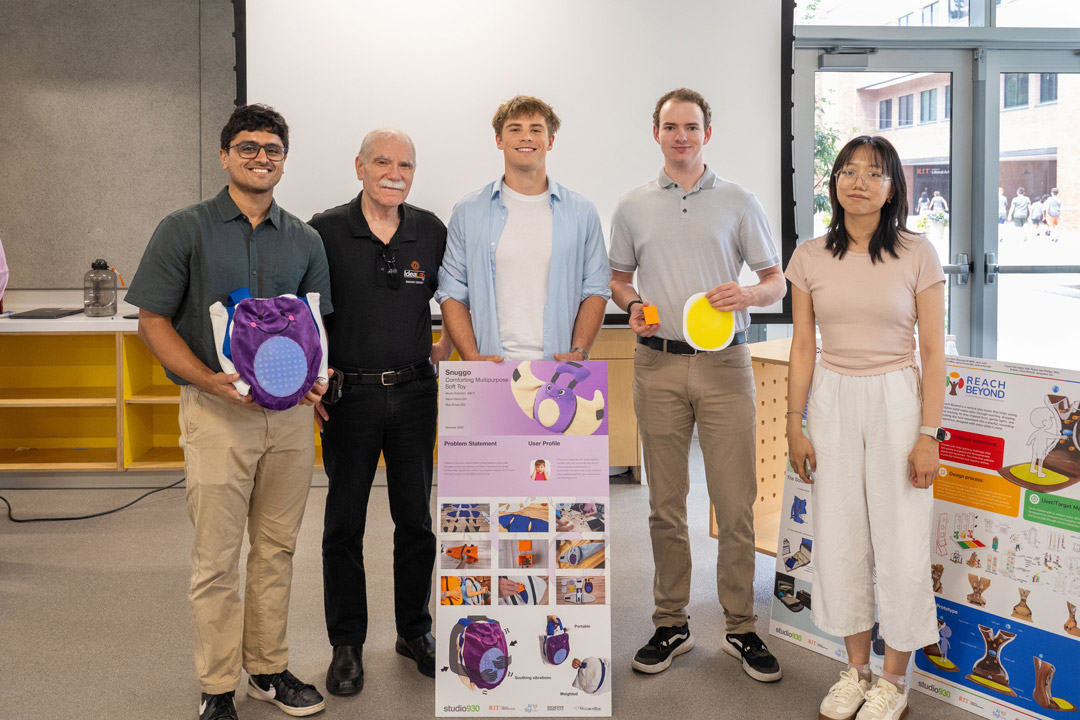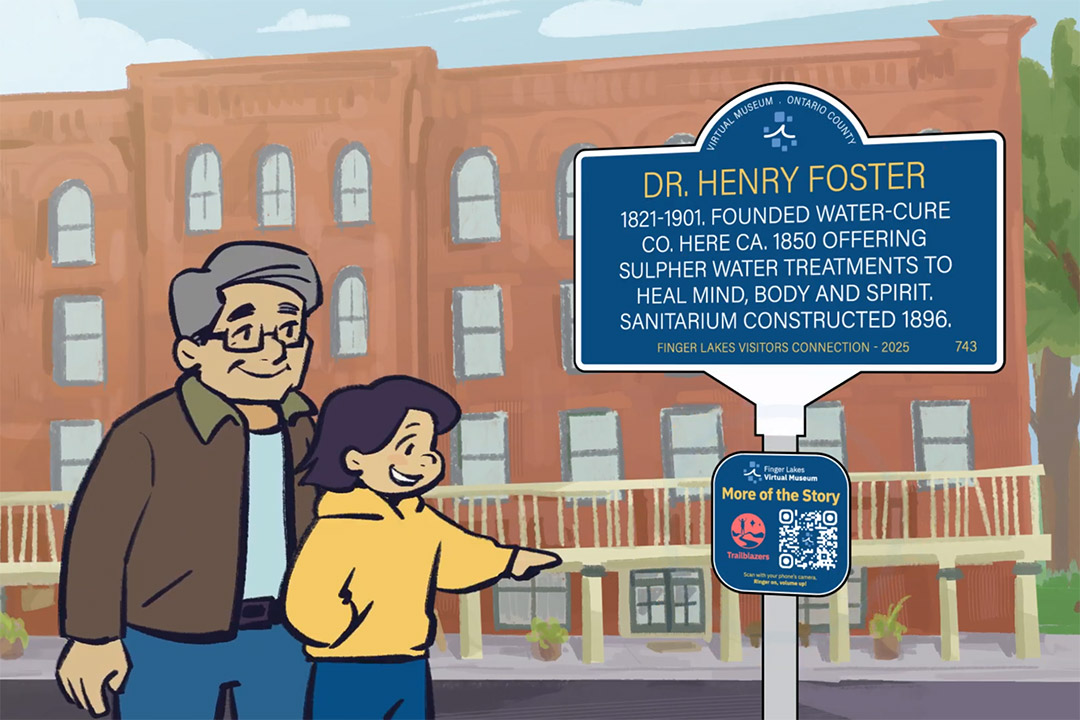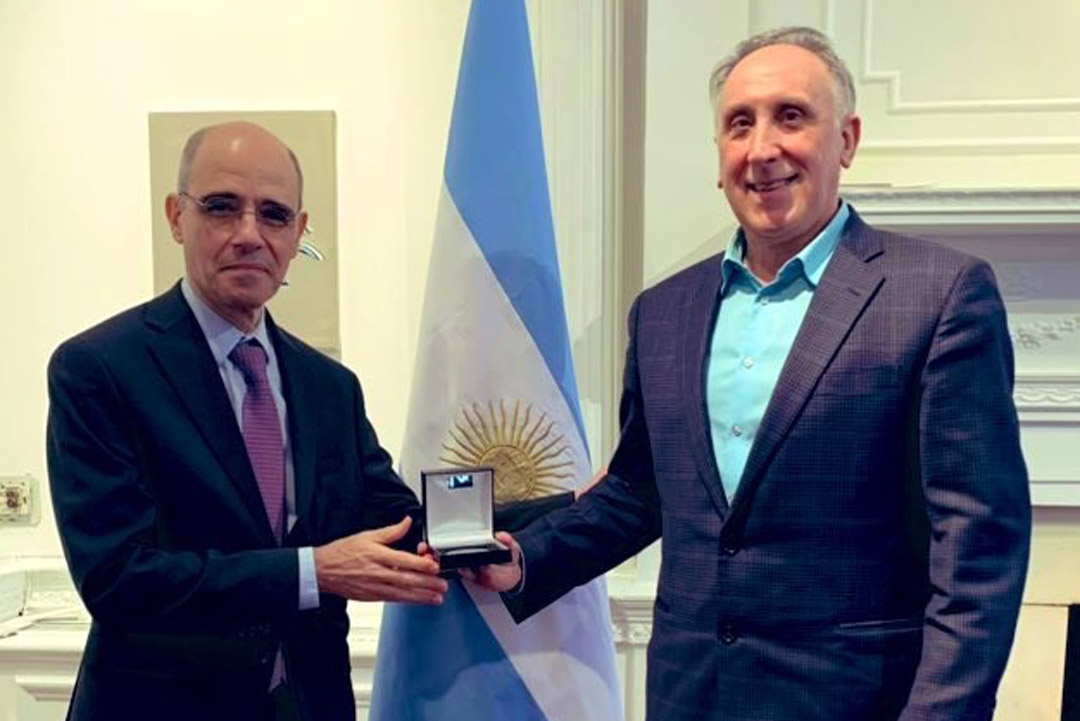Ph.D. student channels her resilience into solutions
Katie (Masaryk) Malarkey ’04 (physics) uses her good days for good. It’s a simple ethos that guides her life.
As an undergraduate at RIT, the Windsor, N.Y., native balanced roles as a resident adviser, lead editor for Reporter magazine, and member of choir and a cappella groups. Her first act after graduation aligned with her major, working as a thin film coating engineer for Newport Corp.
“I used to tell people I made rainbows for a living,” Malarkey joked, reflecting on her five-year career creating diffraction gratings.
Despite her success, something wasn’t right. After years of daily migraines, overwhelming lethargy, and painful physical changes, Malarkey was diagnosed with acromegaly, a rare condition caused by a pituitary tumor that produces excess growth hormone.
She considers that day one of the best of her life because she finally received a diagnosis for all her mysterious symptoms.
After subsequent and ongoing years of treatment, including radiation and brain surgery, she adjusted her priorities.
“My time as an engineer taught me to think critically and solve intricate problems,” she said. “But my health struggles taught me the value of perspective. If you can find the little joy in every day, it makes life a beautiful experience.”
Malarkey returned to RIT to tackle complex environmental issues. As a Ph.D. student at Golisano Institute for Sustainability, her research focuses on agricultural plastics—a largely overlooked contributor to environmental pollution.
“We rely on plastics for so much of our food production, from mulch films and irrigation tubing to greenhouses and horticultural containers,” she explained. “Yet we don’t even know how much plastic is being used, let alone how to recycle the majority of it.”
Her study, funded by a $15 million National Science Foundation grant, provides a comprehensive quantification of plastics used annually in U.S. agriculture. Her work also aims to address the end-of-life challenges for these materials.
Many agricultural plastics, contaminated with dirt and organic matter, are nearly impossible to recycle and often end up in landfills. Their breakdown releases microplastics into soil and water, potentially entering the food chain.
Malarkey hopes to help identify and mitigate those obstacles to create circular economy solutions.
“Katie has what we call that ‘secret sauce,’” said Callie Babbitt, professor of sustainability and Malarkey’s research adviser. “She has the intellectual curiosity, creativity in her approach, and the grit to overcome obstacles. She’s balancing so much in her life, but you wouldn’t know it because she shows up every day with a positive attitude.”
That balance includes juggling her responsibilities as a mother of two children and her work in the community. She is co-president of Parenting Village, a Rochester-based nonprofit that offers free support to local caregivers and families and hosts an annual Family Fest that draws thousands.
To Malarkey, sustainability is more than policy—it’s about fostering relationships on every level.
She embraces it all with gratitude and determination. “Coming back to school at this stage of life isn’t easy,” she said. “But the support I’ve found at RIT and from my family has made all the difference.”
Latest All News
- State renews AMPrint Center’s contract to continue advancing 3D-printing technologiesRIT’s AMPrint Center recently received a 10-year renewal contract from New York state to continue development of next-generation 3D-printing processes, materials, and applications. The renewal funding will be distributed in two five-year increments, and the first allotment of $5 million will be used beginning this fiscal year. The AMPrint Center was established in 2015 to help position New York state as a global leader in 3D-printing technologies through industry, government, and academic partnerships. New start-ups have matured in the state through AMPrint’s research, training, and support capabilities. Its team has also contributed technology to improve how high-performance materials, including metals and carbon fiber composites, are being used in 3D-printing applications, said Denis Cormier, director of the AMPrint Center. “The AMPrint Center is helping to breathe new life into this region’s world-renowned printing industry by applying its expertise to the rapidly growing 3D-printing universe,” said Cormier, the Earl W. Brinkman Professor of Industrial and Systems Engineering in RIT’s Kate Gleason College of Engineering. The center has an extensive range of high-tech 3D-printing equipment being used for research as well as hands-on educational and training resources for students, faculty-researchers, and corporate partners. According to Wohlers’ Associates, the global report on 3D printing and additive manufacturing stated that the industry grew from $5.1 billion in 2015 to nearly $22 billion in 2024. This renewal grant is a result of the integral work provided by AMPrint: to support and launch start-up companies and to help existing companies successfully adopt industrial grade 3D-printing and additive manufacturing technologies in real-world applications. For example, AMPrint is helping Rochester-based 3D printer company Impossible Objects develop a machine that produces ultra-strong and lightweight carbon fiber composite components. Impossible Objects recently installed what it refers to as the world’s fastest 3D printer, the CBAM-25 machine, in the AMPrint Center. The new printer becomes another in a series of high-end, high-tech—and very fast—3D printer assets at the university, and multiple funded projects are already underway at the AMPrint Center using this new carbon composite 3D printer. “There’s an acute need for high-speed 3D printers that can produce very strong, very light weight components for drones and other applications,” Cormier explained. Additional applications include the development of custom-made carrier boards for the soldering process used to make electronic circuit boards. With the newer, faster printing process, Impossible Objects’ capabilities reduce both time and cost to production. “This is a ground-breaking piece of industrial manufacturing equipment,” said Cormier. “If you visualize a digital printing press making magazines or newspapers, the paper is just flying through the machine. Now translate that into 3D printing; that is what Impossible Objects has done. They are using carbon fiber instead of paper. There isn’t any 3D-printing technology that touches this machine's print speed, while simultaneously making such high strength parts.” Beyond speed and strength, AMPrint has also been leading the development of a 3D printer that operates like an inkjet printer in which the ink is molten metal. Cormier recently received a $3 million Future Manufacturing Research grant from the National Science Foundation to bring this technology closer to commercialization. Specifically, the team is scaling up the speed of this printing technology and is also expanding the types of molten metals that it can print. They expect to see it in commercial use within the next five years. “I’m biased of course, but I believe that this metal 3D-printing technology has the potential to transform the way many metal parts are made. Instead of mass-producing parts that are shipped halfway across the world for storage in huge warehouses, it will be possible to locally print metal parts on-demand just before they are needed,” said Cormier. On campus, several 3D-printing classes are available for undergraduate and graduate students using the AMPrint Center's broad range of equipment to ensure there is a pipeline of skilled engineers that can incorporate 3D-printing technology into varied industries. These classes range from Introduction to 3D Printing and Personalized 3D Printing to Metal and Composite 3D Printing. Students are learning about 3D printing processes and applications through coursework, research projects, and internships with the AMPrint Center's industry partners. Companies can also use any of the different industrial-grade machines or provide prototype devices for testing before commercialization. The AMPrint Center is involved in a diverse range of other industry and government funding projects. A collaboration between RIT and Alfred University is underway to develop a novel technique for 3D-printing glass structures that can go from ultra-low to ultra-high temperatures without cracking or breaking. The center team is also helping a company to develop a 3D printer capable of producing full color customized dentures.
- Tiger Tutor Team prepares for second year with Rochester studentsLily Yengo loves math, kids, and fellow nerds. The fourth-year mechanical engineering student participated on the Tiger Tutor Team this past spring semester, working with accelerated fifth graders in the Rochester City School District to ensure they retain their love of math. This summer, Yengo is helping to enhance instructional materials—adding and testing new activities and problems-- and providing improvements to the overall process of recruiting and training new tutors for the upcoming academic year. Based in the industrial and systems engineering department, the Tiger Tutor Team began in the 2024-2025 academic year, and more than 60 RIT students tutored five eighth-grade classes and one group of talented fifth graders at three Rochester schools: Loretta Johnson Middle School, School of the Arts, and No. 12 School. The goal was to keep students in accelerated programs excited about, and engaged in, math, as well as improve passing rates for those taking the New York State Regents exams. “I love working with kids. I love math, I’m a huge nerd and so working with these super smart kids who are huge nerds—and I mean this in the most loving way possible—they were there because they wanted to be there. They wanted to learn algebra and trigonometry in their free time. So, we taught them,” said Yengo, who is from Skaneateles, N.Y. Yengo is currently on co-op in Rochester for the DDS Companies, creating base maps of underground utilities to be used in natural gas main installations. She assesses historical records and current photos to compile a map with all the necessary information above and below ground. Yengo talked about the tutoring work and her inspiration for teaching. What is the Tiger Tutor Team? And who were the students you worked with? It’s very new. Dr. Katie (industrial engineering department head Katie McConky) began a partnership with the Rochester City School District and invited engineering and math students to volunteer. She said if you like working with kids and if you like math you should be a Tiger Tutor, and I was like yeah… perfect! There were about 15 of us that worked with the fifth-grade students in groups of three or four. What are you doing this summer to support the program for the upcoming academic year? Sometimes it’s trial by fire and you just need to throw it together and see what works and what doesn’t. We didn’t have a curriculum per se, so my job now is to do that work so that next semester’s tutors are prepared. Everything will be ready. I may not have known how to teach someone the quadratic formula, but my job over the summer is to prepare a guide for the tutors with worksheets and answers, just to make everything more streamlined. Coming up with math problems on the fly is really hard. Why is work like this important for you, your peers, and the fifth graders? For me, at RIT, I am a student, I am there to learn and I’m trying to soak up as much calculus as I can, because it is really hard. But with the kids, it is such a different age demographic. It’s fun to talk to them and these kids are fun. As someone who grew up in public schools in situations similar to them, I loved learning and would have loved to have a program like this—a program to push the boundaries of what I knew. To succeed in something that challenging is rewarding—for them and for us. And you can tell that they know that is really hard, and that’s why they like it too. When we do algebra together, they are asking questions, talking to each other, they are showing each other their work, it is a bigger conversation. How did you prepare for fifth graders who want to take eighth-grade advanced math classes? I’ve got to shout out to my mom. She was a teacher her whole life, now she is a principal. I have always been around kids. I’ve gone to her classroom after school and hung out with her and whatever kids she was teaching at the time. I’ve taken a lot from her to do this job. We’ve probably talked about this job more than any other that I’ve had because she cares about algebra curriculums, that’s her thing. She loves teaching. I learned the most from my mom about this. To learn more The pilot year saw significant gains in mastery rates for students taking the Algebra Regents exam, according to the RCSD Department of Math. RIT’s Tiger Tutor Team is seeking additional tutors and is expecting to expand to include both fifth and sixth graders from School No. 12. The time commitment for tutors is approximately two hours per week. To get involved, contact Professor Katie McConky at ktmeie@rit.edu.
- Studio 930 students create assistive solutions for real-world challengesGive teams of RIT students a design challenge, a 10-week deadline, and real clients in need of practical solutions, and they will rise to the occasion. Now in its 10th year, the interdisciplinary and collaborative Studio 930 program asks students to apply what they know, learn what they don’t, and design products that make life, or a single task, more efficient and accessible. Four teams presented their design solutions to clients from the Al Sigl Community of Agencies and Rochester Regional Health on July 16 in the SHED’s Brooks H. Brower Maker Showcase. Students working with the Al Sigl Community of Agencies designed:“Snuggo,” a wearable sensory toy/vest fashioned as a stingray to help calm children with autism spectrum disorder; and A freestanding, interactive play system to promote motor development skills. Teams assigned to Rochester Regional Health focused on projects to improve workflow obstacles identified by nurses and physical therapists in the health system. Their solutions included:A sturdy, but lightweight, medical bag with multiple compartments and a table to assist visiting home care nurses and physical therapists; and A mechanical bandage dispenser that opens the wrapper while keeping the gauze sterile—a task made difficult while wearing protective gloves. “Snuggo” team member Varun Varma, an MFA industrial design student from Mumbai, India, learned about bringing a concept to life. “It was really new to me because working with soft toys is something that requires a lot of sewing and using fabrics,” he said. “I’m used to conceptual projects, but this was manufacturing something physical, so that was very new to me, and I enjoyed it.” Noam Arenstein, a fourth-year mechatronics engineering technology major from Scarsdale, N.Y., applied to Studio 930 for the experience of working on a multidisciplinary team in preparation for entering the workforce. Later, he learned he could earn co-op credit from participating in the program, as well. Studio930 introduced Arenstein to the process of design thinking and prioritizing the needs and perspectives of the end user and other stakeholders. “I’ve never worked on a product that is tailored to other people’s concerns,” Arenstein said. “One of the new experiences for me was including empathy when it comes to design.” Supported this summer by the School of Individualized Study (SOIS), Studio 930 has its roots in the industrial design department. Stan Rickel, associate professor in the School of Design, started the program in 2015 to give industrial design MFA graduates client-driven work experience. When a couple of engineering students heard about the idea and joined the group, Rickels saw how Studio 930 could expand. “The enthusiasm of the students kept it moving,” Rickel said. “This year, we had 15 students in the program from five different colleges and eight different academic programs.” The collaborative, client-based program also draws like-minded RIT professors whose interests complement and sometimes overlap. Engineering professor Dan Phillips, for instance, helps recruit students and elicit college support. He also solicits and assesses challenges from participating community partners. The bandage dispenser designed for Rochester Regional Health is one example of students brainstorming concepts with advice and feedback from the client, a strategic partner in the RIT-RRH Alliance. Studio 930 is both a program and a community that revolves around collaborative and interdisciplinary teamwork focused on accessibility and healthcare, according to Dan Harel, the studio’s manager and adjunct professor of industrial design. Studio 930 operates from the SHED, giving students easy access to makerspaces, materials, and meeting rooms. The facility, which opened in 2023, provides a common space for the Studio 930 teams, which, in the past, had been scattered in workshops across campus. Offering the program in the SHED has made a difference in the quality of the students’ projects, Harel said. “You get bigger ideas when you have the room to spread out and play with different processes.” Proximity to different technology, from textiles to 3D printing, in one facility encourages creative thinking, he said. “We were able to generate more and quicker prototypes using materials that are available here, or that we purchased, and everything went faster,” Harel said. “The students were really inspired by the open environment and interactions with visitors. You know, people come and see what you’re working on, and it’s really encouraging to students.” Along with SOIS, Studio 930 was sponsored by the industrial design department within the College of Art and Design, the College of Engineering Technology, the Kate Gleason College of Engineering, and the Waldron Rise Foundation.
- App blends history, technology, and student talent in new tourism initiativeA collaboration between RIT and the Finger Lakes Visitors Connection is about to change how people experience local history in Ontario County, N.Y. The Finger Lakes Virtual Museum app—developed primarily by students and set to launch publicly this fall—is a digital storytelling platform that combines historical content with technology to create immersive visitor experiences. The idea began with Finger Lakes Visitors Connection, the county’s official tourism promotion agency, which wanted to add “more of the story” to historic markers across the region. Backed by a grant from New York State Empire State Development, the project was brought to RIT’s MAGIC Spell Studios to engage students in real-world development work. “This is exactly the kind of hands-on, real-world experience that students need,” said Diane Linnet, project director, business development and adjunct professor at RIT. “It’s not hypothetical. They’re working with clients, managing deadlines, solving creative and technical challenges, and seeing the direct impact of their work on the community.” A multidisciplinary team of students collaborated over the past year on everything from design and user experience to content creation, and included 2D- and 3D-digital storytelling, augmented reality, photo and video production, and location-based interactive activities. Provided RIT student Jason Salazar Tobar, who was augmented reality developer on the project, used the experience to reflect on the cultural impact of his work. When launched, the app will be accessible through a web platform and as a downloadable mobile app. Visitors to Ontario County will be able to scan QR codes on historic signs and access curated digital content that adds to each location’s story. Jason Salazar Tobar, a fourth-year individualized program major from Mount Kisco, N.Y., served as augmented reality developer, and used the project to continue exploring his interest in how emerging technologies can intersect with art, culture, and live performance. This past March, he and Max Stromfeld ’25 (graphic design) debuted a prototype of the app during a conference in Dubrovnik, co-organized by RIT Croatia. “This project gave me a whole new perspective on the museum world,” said Salazar Tobar. “I started thinking more like a curator and asking deeper questions like, ‘What are we trying to make the user feel?’ It pushed me to go beyond just making something cool and really considering the cultural impact of the experiences I was building.” Linnet added that projects like this are helping to enrich the region’s tourism while preparing students for industry. “We’ve already seen students go into interviews where this project was a major conversation point,” she said. “That’s the kind of return on investment that benefits everyone—students, universities, and communities.”
- Lousto honored with Argentine award for outstanding scientific contributionsCarlos Lousto, Distinguished Professor in the School of Mathematics and Statistics, is a recipient of the 2024 RAICES Award, granted by the Secretariat of Innovation, Science, and Technology (SICyT) of the Argentine government. The RAICES award, or Redes de Argentinos Investigadores, Cientificos y Tecnologos en el Exterior, recognizes distinguished Argentine scientists living abroad who make notable scientific contributions in strengthening science and technology capabilities in their home country. “Thank you to RIT for all the support to perform top research during my already 18 years working here!,” said Lousto. “This award encourages me further to keep working hard.” Lousto was officially recognized with the award at the Consulate General of Argentina in New York in early July alongside fellow honoree Viviana Zelizer of Princeton University. “This recognition is a significant testament not only to Dr. Lousto’s outstanding career and continued global influence, but also to the remarkable depth of faculty talent we have at RIT,” said College of Science Dean Andre Hudson. “It underscores the vital role that international scholarship and collaboration play in advancing the frontiers of science and education.” RAICES awardees are selected by a jury composed of authorities from SICyT, CONICET, and prominent academics. Lousto is a co-director of RIT’s Center for Computational Relativity and Gravitation and has been involved in groundbreaking research on gravitational waves, black holes, and pulsars. He was awarded membership in the Alexander von Humboldt Foundation in 1993, the American Physical Association (APS) in 2012, and received the Bouchet Prize in 2019. He was also recognized with the Breakthrough Special Prize in 2016 for his work leading to the first detection of gravitational waves from the merger of two black holes. He was officially nominated by the US Congress for his research work in 2006 and 2016. He received a Ph.D. in astronomy from the University of La Plata and a Ph.D. in physics from the University of Buenos Aries. He designed the Funes, Newhorizons, and BlueSky supercomputer clusters that perform binary black hole simulations and has authored or co-authored approximately 300 scientific articles in international journals.
- RIT names three new members to university boardRIT has appointed three new members to its Board of Trustees. Jane Elliott ’88 (accounting) is executive vice president and chief human resources officer at NCR Voyix, with decades of experience in accounting, finance, investor relations, and strategy. In her role, Elliott creates and executes the company’s people strategy to support growth objectives. She has also served in the top human resources role at three publicly listed companies. She has served on the RIT President’s Roundtable since 2019 and the Saunders College of Business National Council since its inception in 2022. In 2017, she created the Jane M. Wentworth ’88 Endowed Scholarship in Saunders College. In 2020, she contributed to the Saunders College expansion project. She has also served on the boards of Junior Achievement of Georgia, and Cool Girls, a nonprofit organization dedicated to the self-empowerment of girls living in Atlanta’s most vulnerable communities. Brenda Haynes, a retired oncologist and hematologist, trained at the Albert Einstein College of Medicine and completed her residency, internship, and fellowship at the University of Pennsylvania’s Perelman School of Medicine. While no longer actively practicing, she maintains affiliations with Harvard Medical School and Newton-Wellesley Hospital, and most recently served as an oncologist with New England Hematology and Oncology. She is the parent of a second-year civil engineering technology student at RIT and she serves as a volunteer on a number of nonprofit organizations. Dr. Haynes and her husband, Dr. Adam Koppel, are members of RIT’s Sentinel Society and have been active supporters of the College of Engineering Technology, College of Health Sciences and Technology, and several student project teams. Chance Wright ’18 (photographic and imaging arts) ’19 (MBA) is a serial entrepreneur having founded or co-founded several companies including Wright Productions and Entertainment; ATL/WYO Productions; Skull Diamond and Heart Capital; Chance Wright Photography; and The Shore Foundation, a Rochester-based nonprofit dedicated to improving the community through equal access to technology, while also impacting the environment by shifting the impact of used technology. He has served on the President’s Roundtable since 2020 and the College of Art and Design’s National Council since 2021. In 2019, Chance and his mother, Pamela Mars-Wright, made a significant gift to the School of Photographic Arts and Sciences. In 2021, Wright supported the Saunders College of Business renovation and expansion project. Elliott, Haynes, and Wright will each serve four-year terms on the board.








